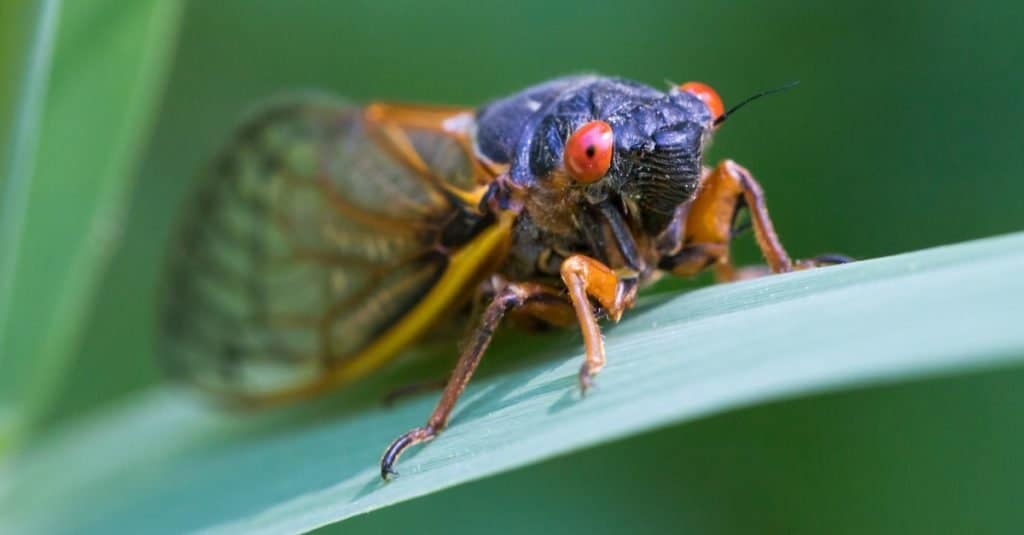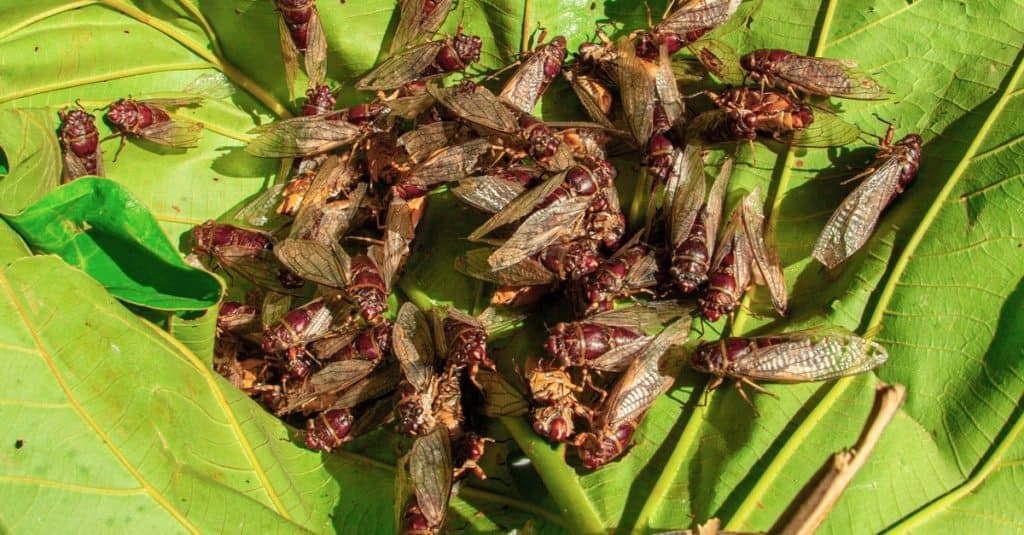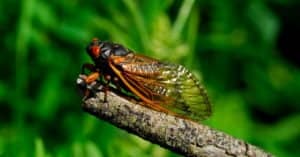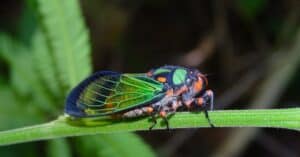If you live in the United States, you’ve probably heard of the emergence of the Brood XIII cicadas. This event happens once every 17 years, filling parks and backyards with thousands of large, noisy insects.
What are cicadas? Should you be afraid of them? Can you see cicadas in other parts of the world? We’re here to map each location that cicadas call home and help you gain a clearer understanding of this fascinating insect.
What Are Cicadas?
Cicadas are insects. There are about 3,000 species found throughout the world.
What do cicadas look like? Adults have thick bodies with large, prominent eyes. Cicadas are usually one to two inches in length. They also have large, delicate wings, clear except for the network of veins running through them. The wingspan can be up to eight inches. Juvenile cicadas shed a brown outer shell that bears no wings and has pointed tips to the feet.
Where in the World Do Cicadas Live?
Cicadas have lived in many parts of the world since prehistoric times, evidenced by fossilized cicadas. They typically live in temperate and tropical climates; they cannot survive in the coldest regions. Cicadas are found on every continent except Antarctica.
Can you find these cicada homes on the map? Many species can be found at each location.
- Australia and New Zealand – several hundred species
- Africa – about 150 species
- North America – over 170 species
- South and Central America – at least 800 species
- Asia and the Pacific Islands – over 200 species
- Europe – a few species, with only one in England
The annual cicada is the most common variety around the world. Representatives of its species can be seen every year. Depending on the species, annual cicadas have an average lifespan of one to five years or more. Some spend more than a decade underground! But the adults’ emergence is not synchronized as it is with the periodical cicada, so some adults are seen every year.
In addition to the annual cicada, North America is also home to the periodical cicada. These cicadas have exceptionally long lives for insects, but most of their lives are spent underground in the nymph stage.
Periodical cicadas reproduce in “broods,” with large groups of perhaps billions of insects emerging as adults, mating, and laying eggs in the same year. These broods spend either 13 or 17 years underground. Scientists give the broods different names to tell them apart. For example, Brood XIII is emerging in the northeastern United States in 2023.
Where will periodical cicadas emerge next? Consider this chart of broods and their location in the United States. Get out your map, and see if cicadas are coming to a state near you.

©Elliotte Rusty Harold/Shutterstock.com
Where Are Cicadas Located? – 17-Year Cicadas
- Brood I – Tennessee, Virginia, and West Virginia – 2029
- Brood II – Connecticut, Georgia, Maryland, North Carolina, New Jersey, New York, Oklahoma, Pennsylvania, and Virginia – 2030
- Brood III – Iowa, Illinois, and Missouri – 2031
- Brood IV – Iowa, Kansas, Missouri, Nebraska, Oklahoma, and Texas – 2032
- Brood V – New York, Maryland, Ohio, Pennsylvania, Virginia, and West Virginia – 2033
- Brood VI – Georgia, North Carolina, South Carolina, Wisconsin, and Ohio – 2034
- Brood VII – New York – 2035
- Brood VIII – Ohio, Pennsylvania, West Virginia, and Oklahoma – 2036
- Brood IX – North Carolina, Virginia, and West Virginia – 2037
- Brood X – Delaware, Georgia, Illinois, Indiana, Kentucky, Maryland, Michigan, North Carolina, New Jersey, New York, Ohio, Pennsylvania, Tennessee, Virginia, West Virginia, and Washington – 2021, 2038
- Brood XIII – Iowa, Illinois, Indiana, Michigan, and Wisconsin – 2024
- Brood XIV – Georgia, Indiana, Kentucky, Massachusetts, Maryland, North Carolina, New Jersey, New York, Ohio, Pennsylvania, Tennessee, Virginia, and West Virginia – 2025
Where Are Cicadas Located? – 13-Year Cicadas
- Brood XIX – Alabama, Arkansas, Georgia, Iowa, Illinois, Indiana, Kentucky, Louisiana, Maryland, Missouri, Mississippi, North Carolina, Oklahoma, Tennessee, and Virginia – 2024
- Brood XXII – Kentucky, Louisiana, Mississippi, and Ohio – 2026
- Brood XXIII – Arkansas, Illinois, Indiana, Kentucky, Louisiana, Missouri, Mississippi, and Tennessee – 2028
Where Are Cicadas Located and Why Do Some Places Have Them While Others Don’t?
You may have noticed that the periodical cicadas listed above are limited to a few states – mostly east of the Mississippi River, with a few in the Great Plains states. Why aren’t periodical cicadas in every state or in other countries around the world?
Cicadas are extremely endemic, meaning that individual species live in just one geographical region. They don’t travel or spread. This is because they spend such a short time as adults.
While periodic cicadas are not found in the western United States or in other countries, many species of annual cicadas are. Some scientists believe that periodic cicadas developed their unique life cycle to survive cold spells or certain predators such as praying mantises. These challenges are unique to eastern North America; elsewhere, annual cicadas employ different survival strategies.
Why are there no cicadas in Antarctica or the coldest reaches of North America and Eurasia? The area also has to have the right habitat for cicadas. Cicadas lay their eggs beneath the bark of trees. When they hatch, the nymphs drop to the ground and burrow into it, and the young insects mature there. Adults climb into the trees after emerging from the ground. The weather has to be right for both the cicadas and the plants they need to survive.
Where Are Cicadas Located and Why Do They Emerge in Swarms?
So, we understand that periodical cicadas spend 13 or 17 years underground. But why is their emergence synchronized? Why do they come out all at once, rather than just a few 17-year cicadas coming out each year like annual cicadas and laying eggs that will grow and emerge in another 17 years?
Scientists believe that mass emergence may help the cicadas survive. Predators, including cats, dogs, birds, foxes, raccoons, and other insects all love to snack on cicadas. When many emerge at once, there are more than the predators can eat, so some will survive to reproduce.
Predatory insects especially have a shorter life cycle, usually about two years. Since the cicadas’ life cycles are much longer, the predators cannot multiply, depending on the cicadas for food.
Cycles of colder-than-average weather may have also influenced the long life cycle of periodic cicadas.
Cicadas are not the only creatures to employ a synchronized reproductive strategy. Certain trees produce seeds only once every few years, and they are synchronized to flower during the same year. Then, so many offspring are produced that the herbivores cannot eat all the seeds or seedlings, just as the predators cannot consume all the cicadas.

©iStock.com/Photour1904
Where Are Cicadas Located and What is a Cicada Emergence Like?
What is it like when a brood of cicadas comes out to play? We asked the travel and adventure blogger Cara Siera to share some memories of the 1998 emergence of 13-year cicadas in Nashville, Tennessee, USA.
“It was really exciting for a kid who loved animals,” Siera said. “We took a school field trip to Centennial Park in Nashville just to see them. They were some of the biggest bugs I’d ever seen. They were everywhere, too – on the ground, on the trees. Their crunchy, brown shells were everywhere, too. If you looked carefully, you could find some still making their way out of the ground, following little tunnels. Many of us played with them, while other kids were afraid. I remember we saw a few pale cicadas, much lighter than the others, and we wanted to protect them because they were special. Now, I know that they were the youngest, newly hatched insects, their exoskeletons still hardening in the sun.”
“The noise was intense – a loud screeching,” she continued. “To this day, when I hear the call of a lone annual cicada, it takes me back to that hot summer when I was eight years old.”
Where Are Cicadas Located and Should You Be Afraid of Them?
No, there is no reason to fear cicadas. They don’t bite or sting. They are not poisonous or venomous. They can’t hurt you, and they’re not interested in scaring you. They only desire to feed on plant juices and find a mate.
Did you know? Some people even eat cicadas! Some Native Americans had a tradition of roasting cicadas in a hot oven. Like grasshoppers and locusts, they are said to taste a bit like shrimp. Some conservationists feel that using insect proteins can help us offset global warming and protect our beautiful planet.
Threats to Cicadas
People have cut down forests for their own purposes for a long time and the forests are diminishing faster than ever. Being that these forests are home to cicada broods, they are in danger of being lost to history if their habitat is lost. These creatures have adapted to their highly specific locations and do not relocate like other animals. In order to avoid this, we need to not only stop human encroachment but help to restore the forests of the world.
What State Has the Most Cicadas?

Cicada Brood X emerges every 17 years and will next be seen in 2038.
©Chris Alcock/Shutterstock.com
While cicadas are found throughout the world, periodical cicadas are unique to North America. These periodical cicada broods are concentrated in specific areas of the central and eastern regions of the United States. Some of these areas are also home to multiple broods, and certain broods, like Brood XIII and Brood XIX, emerge simultaneously, an event that hasn’t occurred in 221 years.
Where to see the most cicadas depends on which brood is emerging. Brood X, which is the largest group of cicadas, emerged in 2021 and will again emerge in 2038, and swarmed more than 15 states. Although they are found in three separate areas, from Pennsylvania and northern Virginia to Indiana, and eastern Tennessee, they were most seen in certain areas of Delaware, Maryland, New Jersey, New York, and Pennsylvania.
The photo featured at the top of this post is © Shot Stalker/Shutterstock.com
Thank you for reading! Have some feedback for us? Contact the AZ Animals editorial team.





